![]() November-December 1999
November-December 1999
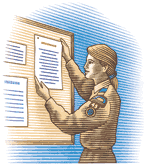
Edited by Scott Daniels
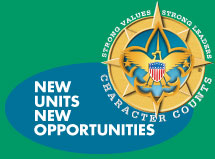
In January, with a goal of at least one pack, troop, crew, and post in every U.S. community and neighborhood, the BSA begins a two-year national Unit Growth Emphasis.
The average number of youth members per unit has not changed significantly in the last 35 years; therefore, more units must be started in order for Scouting to have an increased impact in the communities it serves.
The program—with the theme "Character Counts: New Units, New Opportunities"—is scheduled to run until Dec. 31, 2001. Its first priority will be to make sure every young person in each public and private school has a unit to join within their school boundary limits.
A recognition program will highlight individual unit-serving executives and council achievement at three levels of growth in packs, troops, teams, crews, and posts: Platinum (10 percent growth); Gold (5 percent); and Silver (2 percent).
Five thousand adult and youth volunteers will serve as
staff members for the BSA's 15th National Scout Jamboree, scheduled for
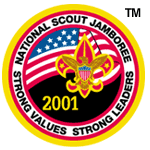 July 23 to Aug. 1, 2001, at Fort A.P. Hill, near Fredericksburg, Va.
July 23 to Aug. 1, 2001, at Fort A.P. Hill, near Fredericksburg, Va.
Examples of areas with staff positions include action centers (shooting sports, motocross, rappelling, etc.), trading posts, arena shows, food service, media and communications, medical, and security.
Positions are open to
adult men and women who meet required qualifications. Adults must have been born
before July 23, 1980. Youth staff members must have been born between Aug. 1,
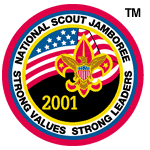 1980, and July 23, 1985, and be registered BSA members.
1980, and July 23, 1985, and be registered BSA members.
The fee for adult jamboree staff is $495; the youth staff fee is $245.
To apply, ask for a National Jamboree Staff Application at your local Scout council service center.
Two official patches
The 2001 National Scout Jamboree will be the first national jamboree to feature two official patches.
The patch for youth participants and junior staff under 18 has a red border. The patch for leaders and staff 18 and older has a gold border.
It all started when Brad Stewart of Troop 223 contacted the Friends of Valley Falls for potential ideas for his Eagle Scout project.
The Vernon, Conn., group takes care of the town's 183-acre park and had long wanted to make the facility's pavilion and playscape, hiking and biking trails, and swimming and fishing opportunities available to more people.
One of their goals was to increase hiking trail accessibility. Some of the park was already navigable by wheelchair, but a limited budget prevented extending this to any hiking trails.
Enter Eagle Scout candidate Brad Stewart. After talking with group members who had close associations with blind and visually impaired people, Brad decided to create a trail that would allow the visually impaired to hike independently and with confidence.
The result was Vernon's Braille Trail. It features an 800-foot path through the woods. One thousand feet of "guide" rope runs through drilled holes in 36 cedar posts and metal rings installed in existing trees.
Eight of the posts support signs in both Braille and large-type print that recount the local history, with references to the flora and fauna of the area.
Knots were added to the rope to signal to hikers that they were approaching one of the signs.
Brad had no trouble recruiting help for the physical labor involved in construction. The cost of materials could have been a problem, but he was able to get several businesses and organizations within the community to donate the lumber, rope, and hardware.
Connecticut's Oak Hill School for the Blind created quality Braille signs at no charge. And the town donated seven yards of wood chips.
Fellow Scouts, leaders, family, and friends turned out over a period of several weeks. In the process, they learned how to operate posthole diggers, removed stumps, assembled trail signs, leveled terrain, and spread wood chips.
The result was a hiking trail for the nonsighted that opened a door to nature's wonders.
Since the project's completion, special-needs organizations, student groups, and individuals have all taken advantage of the trail.
And an ongoing project will extend the trail through larger sections of the park.
—Annie Gentile
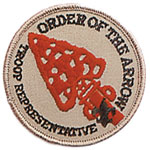
A new youth leadership position for boys in Scout troops and Varsity teams is the Order of the Arrow representative. The representative serves as a program and communications link between the local OA lodge or chapter and his unit.
His
duties are to encourage (1) older-Scout participation in high adventure programs,
(2) year-round and resident camping in the troop, and (3) Arrowmen to assume leadership
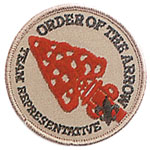 positions in the troop, participate in lodge and/or chapter activities, and seal their
OA membership by becoming Brotherhood members.
positions in the troop, participate in lodge and/or chapter activities, and seal their
OA membership by becoming Brotherhood members.
The representative also assists with leadership skills training in the troop; sets a good example; wears the uniform correctly; lives by the Scout Oath, Law, and OA Obligation; and shows Scout spirit.
The OA troop or Varsity team representative must be an OA member who is not yet 18 years old. He is appointed by the senior patrol leader with Scoutmaster approval.
If you think that old Cub Scout neckerchief you wore in the second grade and the patch you got at Philmont back in the 1960s only have sentimental value, think again.
Many articles of Scouting memorabilia tucked away in attics, storerooms, closets, and bureau drawers can be worth—to collectors—a lot more than you think. For example, memorabilia aficionados might pay up to $1,500 each for early Order of the Arrow medals.
Some BSA councils are finding a fund-raising bonanza in these "hidden treasures."
The Cascade Pacific Council in Portland, Ore., for example, earned more than $45,000 from four memorabilia auctions held during the 1990s. The latest of these, conducted at the council's Scouters Mountain training center last year, brought in about $11,000 for the council's endowment funds.
"You'd be amazed at how many people collect old Scouting stuff," says Ed Harris, the veteran Scouter who helped organize the auctions. "This [event lets] collectors get something for themselves while giving something back to Scouting."
Harris is a prolific collector of "old Scouting stuff" himself. What started as a casual hobby more than 35 years ago became such an "all-consuming activity" that Harris has amassed enough memorabilia to turn the entire first floor of his split-level home into a Scouting museum.
"Old insignia, merit badges, uniform components, and handbooks are always in demand," he says. "And so are old calendars and copies of Boys' Life and Scouting magazines, but I guess the biggest activity of all is in patches."
Two recent ceremonies featured Scouts involved with one really large Star-Spangled Banner and several rare versions of Old Glory.
The parade highlighted the three-day celebration marking the 200th anniversary of the county's official creation in 1799.
The first flag, carried by uniformed Scouts and raised at Pittsburgh's Flag Plaza, featured 50 stars that were handmade by the governors of the 50 states. Also unfurled was a giant, 30-by-60-foot replica of the original 13-star Stars and Stripes. Known as the "Betsy Ross flag," it will serve as a city landmark atop a 130-foot flagpole in front of the Pittsburgh Steelers' new football stadium.
In addition, Scouts carried all 50 state flags, as well as their own unit flags, during the inspiring patriotic ceremony.
The award will be presented to outstanding unit commissioners in each district who "exemplify the Scouting spirit."
And the ceremony included a bit of déjà vu for its oldest participant, Scouter Dick Eiseman, 98. Recipient of the council's first Silver Beaver Award 67 years ago, Eiseman also attended the lodge's original dedication in 1954.
Traveling on a budget? Hostelling International-American Youth Hostels (HI-AYH) offers an annual publication, Hostelling North America: The Official Guide to Hostels in Canada and the United States, that can help save you money. The 400-page 1999 edition, which costs $3, lists details and reservation information on 220 hostels in the United States and Canada.
Hostels are inexpensive, dormitory-style accommodations for travelers of all ages. They provide separate facilities for males and females, fully equipped self-service kitchens, dining areas, and common rooms for relaxing and socializing. Many also have private family/couples rooms that can be reserved in advance.
In addition, HI-AYH has a free color brochure, "Hostelling Map of the U.S.A.," which lists its 142 U.S. hostels, including location, address, telephone number, and open dates (some locations are seasonal).
Order the book and/or brochure from HI-AYH [specify map brochure or Hostelling North America], 733 15th St., N.W., Suite 840, Washington, DC 20005; (202) 783-6161; e-mail hiayhserv@hiayh.org.
Starting Point, published by the American Volkssport Association (AVA), lists 1,200 year-round and seasonal walking trails nationwide. The book also highlights the 10 favorite walks chosen by AVA members, with the 6.2-mile Washington, D.C., Monument Walk topping the list. The book is $10.95 plus $3 shipping and handling from AVA, 1001 Pat Booker Rd., Suite 101, Universal City, TX 78148, or by credit card order at (210) 659-2112. In addition, a free information kit, with a list of AVA clubs nationwide, is available by calling (800) 830-WALK (9255).
The time-honored Scouting terms jamboree and camporee have given rise to a host of creative local "o-ree" spin-offs.
Each spring, for example, the Central States Scout Museum at Larned, Kan., holds an annual Scout Memorabilia Auction and Trade-O-Ree. The Ohio River Valley Council stages a Spring Cub-O-Ree, while the Sam Houston Area Council in Texas invites Cub Scouts to test their mettle in a 12-event Tough-O-Ree. In the Cascade Pacific Council's Willamette District, Webelos Scouts and their parent partners attend a weekend Webeloree.
At Halloween, troops in the Fox River District in Wisconsin's Potawatomi Area Council staff a game-filled Creeporee, while the East Carolina Council entertains families with a Spook-O-Ree at the council camp near Kinston, N.C.
For 23 years the Detroit Area Council has held a fund-raising Good Scout Lunch-O-Ree, honoring individuals who exemplify the ideals of Scouting. (The 1999 luncheon raised $435,000, a record for the event.)
California's San Gabriel Valley Council hosted its first Scout-O-Ree for Boy Scouts, Webelos Scouts, Venturers, and Explorers last spring, featuring games, aquatics, and a campfire show. In August, Scouts in the Blackhawk Area Council attended the fourth annual Meth-o-ree, sponsored by United Methodist Men, Scouting Ministries, and the Northern Illinois Conference of the United Methodist Church.
—Bill Sloan
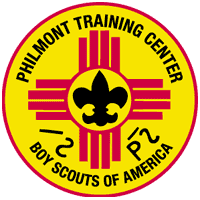
The Philmont Training Center (PTC), the BSA national facility at Philmont Scout Ranch near Cimarron, N.M., celebrates its 50th anniversary next year with a wide range of training conferences from June through September for council and district volunteers and professionals. Also available is a full schedule of age-specific activities for family members.
Families arrive on Sunday and depart the following Saturday. Meals are served in dining halls. Housing is in large, two-person wall tents on platforms, equipped with electricity, bedding, and towels, located near showers, restrooms, medical facilities, and recreation areas.
Conference fees (meals, lodging, conference and program materials) are as follows: conference participants, $265; spouses and children over 18, $200; children, aged 6 to 18, $160; children, 3 to 5 years, $100; children, aged 2 and under, $25. A Mountain Trek for teen-agers is $190; National Junior Leadership Instructor Camp, $200.
Participants must have local council approval. Contact your council service center or write Mark Griffin, Director, Philmont Training Center, Cimarron, NM 87714, (505) 376-2281, e-mail philptc@cimarron.springercoop.com
The 50th anniversary summer/fall 2000 schedule:
* Professional Development Conference.
** Participation in this conference requires completion of a Philmont Health and Medical Record and excellent physical condition.
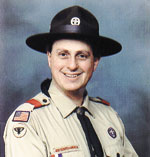
Jonah Treibwasser, assistant Scoutmaster of Troop 128, Rhinebeck, N.Y., is the 1999 recipient of the AFL-CIO's George Meany Award, which honors union members for their outstanding service to youth as volunteer Scouting leaders. A 10-year Scouting veteran, Treibwasser also serves as chairman of the Hudson Valley Council's Tri-Valley District Jewish Committee on Scouting.
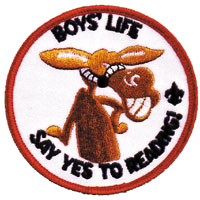
Young readers have two months left to enter the 1999 Boys' Life "Say Yes to Reading!" contest.
Entrants submit a one-page report on "The Best Book I Read This Year." Books can be fiction or nonfiction, entered in one of three categories: 8 years old and younger; 9 and 10 years old; and 11 years and older.
The contest is open to all Boys' Life readers, and all entrants receive a free Pedro patch—but only if they include a letter-size, stamped (33 cents), self-addressed envelope with their report. (Include name, address, age, and grade in school with each book report.)
The top three winners from each age-group will also get a Leatherman multi-tool, copies of Codemaster books 1 and 2, and a limited-edition Codemaster pin-and-patch set, as well as have their names announced in Boys' Life.
Send reports and patch return envelopes to Boys' Life Reading Contest, S204, P.O. Box 152079, Irving, TX 75015-2079. Entries must be postmarked by Dec. 31, 1999.
Share your high adventure plans
The editors of Boys' Life are looking for "Super Scout Outings" to feature in future issues. As far in advance as possible, send the itinerary of your unit's trip, along with the trip leader's name, address, and daytime phone number, to Boys' Life Super Scout Outings, S216, 1325 W. Walnut Hill Ln., P.O. Box 152079, Irving, TX 75015-2079.
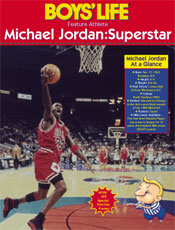
New edition for youngest readers
All Tiger Cubs and any Cub Scouts through age 9 now receive a special tear-out poster in their issue of Boys' Life magazine.
The poster folds out to 16 by 20 inches and features photos on one side and four pages of fun articles on the other.
Two other versions of Boys' Life, designed with age-appropriate reading levels, continue to be published. One version goes to Cub Scouts aged 10 and older, the other goes to all Boy Scout subscribers.
| The Boy Scouts of America | http://www.scouting.org |